
Perhaps I just have a bias against parallel dimensions (as evidenced from my interpretation of Silent Hill's otherworld), but I want to take some time to clear up what might be a mis-conception in the conventional wisdom interpretation behind Dark Souls' multiplayer summoning mechanics. Dark Souls co-op is not necessarily based on parallel dimensions, as many players seem to assume. It might, in fact, be intended to be an abstraction of some kind of time travel. I've noticed that many players online already seem to refer to the multiplayer mechanic of these games in terms of time travel, but I've yet to see any wikis, lore videos, or blogs that seem to explain multiplayer as a time travel mechanic.
I want to preface this analysis by stating that I'm not asserting that the following explanation is the absolute, 100% correct interpretation of the mechanic. Individual players may disagree based on their own reading of the game, and I'm personally somewhat conflicted on the topic myself. I merely want to propose this as a possible alternative to the defacto "parallel worlds" interpretation. I'm going to point out in-game evidence that supports the idea that Dark Souls' multiplayer is based on time travel, but there is also in-game evidence and mechanical evidence that flat-out contradicts that interpretation. I will address those contradictions as well. So that being said, please keep an open mind, and enjoy the read!
The summoning mechanic
There are two games in the series that are not part of the Dark Souls franchise, and which have different in-game explanations and rules for the same multiplayer features (more or less). Those games are, of course, Demon's Souls and Bloodborne. Both have asynchronous multiplayer and summoning mechanics that work similarly to Dark Souls.
Demon's Souls summoning operates under the idea of summoning the spirit of a fellow adventurer who's soul is trapped in the Nexus. This is why you must be in soul form in order to be summoned. Bloodborne's beckoning operates [similarly] under the principle of manifesting hunters out of dreams (which seems to operate under a similar cyclical paradigm to Dark Souls, but I'm not 100% sure). In Dark Souls, you aren't necessarily summoning ghosts (as you do in Demon's Souls), since the undead in Dark Souls are more akin to zombies than ghosts. Also, characters in Dark Souls can leave summon signs whether they are hollowed (dead) or in human form (revived), which is a significant alteration from Demon's Souls. A lore reason for summoning is provided in Dark Souls:
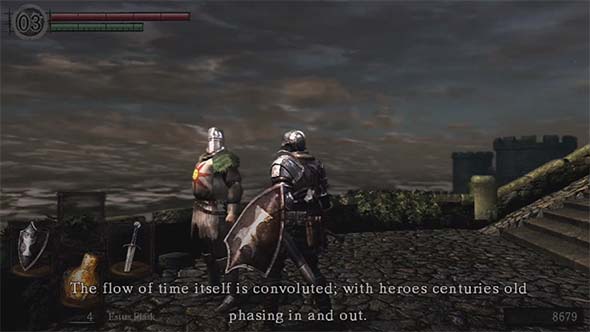
Solaire explains to us how summoning works:
"We are amidst strange beings, in a strange land.
The flow of time itself is convoluted; with heroes centuries old phasing in and out.
The very fabric wavers, and relations shift and obscure.
There's no telling how much longer your world and mine will remain in contact.
But, use this, to summon one another as spirits, cross the gaps between worlds, and engage in jolly co-operation!"
Both Solaire's dialogue, and the White Sign Soapstone (along with other online play items) make references to other "worlds", which leads to many jumping to the conclusion that each player's game is a sort of parallel universe within the Dark Souls lore. However, this may not necessarily be correct. Both Solaire's dialogue and the soapstone also provide explanations for these worlds: "time is convoluted | distorted". This seems to be the explanation for what is meant by "worlds", and it seems that Solaire and the in-game descriptions may be using "time" and "world" interchangeably (could it be a translation / localization issue?). The phrasing in the white soapstone's description joins "the flow of time is distorted", and "the White Soapstone allows undead to assist one another", into a single, compound sentence, which definitely implies that the two phrases (and ideas) are linked.
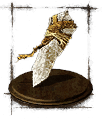
"Online play item. Leave summon sign.
Be summoned to another world as a phantom through your sign, and defeat the area boss to acquire humanity.
In Lordran, the flow of time is distorted, and the White Sign Soapstone allows Undead to assist one another"
The dialogue of Saulden (the Crestfallen Warrior of Dark Souls II) is even more explicit... [More]
b4b5ccdc-fe67-4add-901b-a41077204778|4|5.0
Tags:Dark Souls, Dark Souls II, Dark Souls III, lore, summon, phantom, multiplayer, From Software, time travel, paradox, grandfather paradox, predestination paradox, parallel dimension, soapstone, Solaire, Crestfallen
Warrior, Crestfallen Saulden, Lautrec, Ringfinger Leonard, Anri of Astora, Sirris of the Sunless Realms, Black Iron Tarkus, Iron Golem, Anor Londo, invasion, Demon's Souls, Bloodborne

A couple years ago, I posted about a burning question in Dark Souls' lore: who is the "forgotten" god of war (first-born sun of Gwyn) who was expunged from the annals of Anor Londo? At the time, the leading theory was that Solaire was intended to be the firstborn god of war, and I tentatively went along with that interpretation. There were a few holes in the theory, a lot of it was circumstantial, and there were even a couple of alternative possibilities. I also wholly admitted that it was very likely that the god of war character simply wasn't present in the original game, except through the lore references in the environment and item descriptions. Dark Souls II did little to answer this question, other than to provide a possible name for the god of war: Faraam. Well, it turns out that Dark Souls III finally answers this question, and all of us who thought it might be Solaire were totally wrong - and may even look foolish in retrospect.
As is so often the case with Souls games, you'll have to work hard to find all the good lore. In this case, you'll need to find and conquer the optional Archdragon Peak area of the game, which, itself, requires that you find the Untended Graves optional area as well.
These statues of the Nameless King resemble the statue and pose of Gwyn in the first game.
Once you make it to Archdragon Peak, you'll be treated with a large, sunny area populated with serpent men that should look familiar to veteran Dark Souls players. I'm still unclear regarding the lore behind these enemies. The original man serpents from Dark Souls were hybrid creations of Seath's experiments. Perhaps the man serpents in Archdragon Peak are the progeny of the original serpent men from Sen's Fortress. More importantly, however, is that Archdragon Peak is also home to the Ancient Wyvern and the Nameless King.
During your encounter with the Ancient Wyvern, you'll get your first clue as to the lore that will be uncovered in this area. You'll find regal statues of a being holding a massive swordspear weapon. The style and pose of this statue may remind you of the statues of Gwyn that you saw in Anor Londo in both Dark Souls and Dark Souls III. The way that the character is standing, and the way that he's holding his weapon looks like he could fit in perfectly standing next to Gwyn in the Anor Londo cathedral...
[More]
7e4d29a3-895e-4a8b-8da9-36053957ccf0|3|4.7
Tags:Dark Souls, Dark Souls II, Dark Souls III, lore, From Software, Hidetaka Miyazaki, God of War, Gwyn, Faraam, Nameless King, Archdragon Peak, Untended Graves, dragon, Dragonslayer Ornstein, Solaire, son, sun, Warrior of Sunlight, annals, Anor Londo, Velka, DLC, Ashes of Ariandel, Ariamis
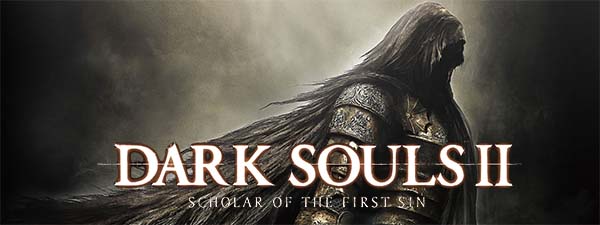
Hot off of playing Bloodborne's The Old Hunters DLC, and with Dark Souls III just over the horizon, I thought I'd get myself hyped up by playing through the re-release of Dark Souls II, Scholar of the First Sin. This version of the game is a next-gen enhancement of the original game that was released on the PS3, XBox 360, and PC a year prior, and it includes improved graphics, faster frame rate, and more challenging enemy-placement. It's available on PS4, XBox One, and PC, and is treated as a completely different game as the original version. It's not a DLC or a patch update (though it does include all three of Dark Souls II's DLC content).
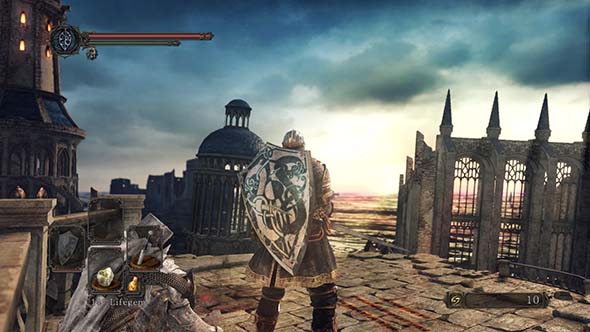
Scholar of the First Sin looks much smoother in motion, with higher resolution and framerate.
Lighting and textures are (at best) only marginally improved from the last-gen release.
I was honestly expecting Scholar of the First Sin's graphics to be considerably better than they are. In fact, I honestly don't think the graphics are much better than the last-gen release; I think the only difference is that it displays at full 1080 resolution and plays at a high end of 60 frames per second. Colors are a little more vibrant, and the game doesn't look as washed-out, but models and environments don't seem any more complex, and textures are only maybe slightly more detailed. Unfortunately, darkness still isn't as dark as it needs to be to make the torch as necessary for exploration as it was apparently intended to be. In pre-release demos, darkness was implied to be a complete fade to black that rendered objects within the dark invisible. Simply adjusting the brightness of your TV wouldn't change that. In the released version, darkness doesn't go completely black, so objects are only hidden if your TV brightness is low - lower than the recommended brightness level of the game. Even then, the release game looks brighter, and Scholar of the First Sin does very little to change that.
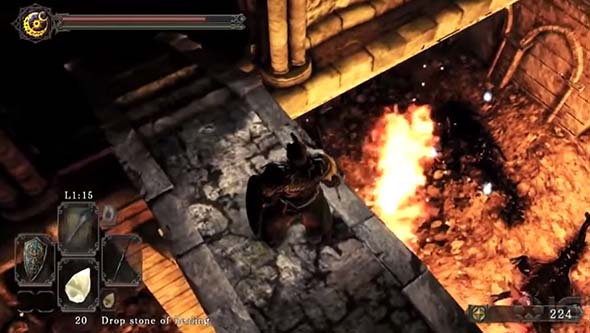
PREVIEW FOOTAGE showcased greater contrast between light and dark, and more detailed textures and geometry...
This graphical downgrade, the complete failure of FROM or Namco/Bandai to inform the public about it, and the resultant misleading marketing that repeatedly showed demos, screenshots, and footage that wasn't representative of the final product left a huge negative impression on a lot of players - especially those who pre-ordered it. That poor initial taste is probably a huge part of the reason why this game has gotten such a negative reception, even though that negative reception is mostly warranted. Scholar of the First Sin was an opportunity to wash that bad taste out of consumers' mouths and give us the game that was advertised, marketed, and pre-ordered. But Namco and FROM didn't bother.
Darkness is just rarely ever a meaningful component of the gameplay. Darkness may lower the range of target locks though, so even though I could plainly see enemies, I felt like I wasn't able to target lock them as readily as I could in the PS3 version. Even so, there's enough sconces laying around that you can light a sconce, extinguish your torch to fight, then re-light it at the sconce after all the enemies have been dispatched. It ends up just being some extra overhead if you care enough to bother with it, and not an essential element of gameplay.
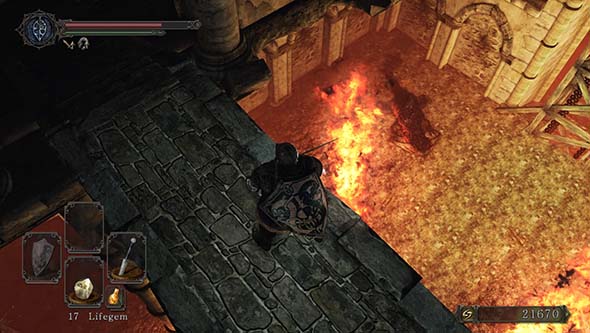
... FINAL PRODUCT shows low contrast between light and dark, frequent repeated textures, and simplified geometry.
Textures, character models, and world geometry don't look noticeably better. Many areas still have generally blander textures than what was presented in pre-release videos, and the textures noticeably repeat. World geometry also seems less detailed and intricate compared to pre-release videos, which takes away a lot of the personality that these preview areas exhibited. I was expecting Scholar of the First Sin to restore many of these superior textures and models from the previews, and I'm really disappointed that the game doesn't look better than it does.
Darker contrast in previews [LEFT] made real-time shadows more vibrant,
and creatures more threatening and mysterious than in the release build [RIGHT].
The improved textures also don't do much to help the game's generally bland art design. There aren't many visually-appealing locations in the game, as they are all just variations of run-down castles and forest paths. Most of them have pretty sparsely-decorated hallways with simple geometry that has little-to-no personality. There's nothing here that even approaches the ominousness of Demon's Souls' Latria, and the oppressive environments of Bloodborne make Dark Souls II almost serene by comparison. Again, Scholar of the First Sin does little-to-nothing to address this. No Man's Wharf probably remains my favorite location in this game, as it's one of the few locations that takes place in a fairly unique setting that actually utilizes light and dark for gameplay purposes.
So while the visual upgrade doesn't really add much to the game, the higher framerate definitely does make a noticeable difference. The PS4 doesn't seem to maintain a full 60-fps at all times, but it seems to always run better and smoother than the 20-30 fps of the PS3 version. Animations are much smoother, and ambient effects (such as foliage swaying in the wind) look much better. I admittedly had to spend some time re-adjusting to the game's speed. After coming back from the rapid pace of Bloodborne, this game almost seemed to be moving in slow motion, and the higher framerate probably contributed greatly to that sensation. That's not necessarily a bad thing; it's just a stylistic difference. Scholar of the First Sin plays smoothly (on the PS4), and it looks decent (even though it should have looked better)... [More]
ac8d6f88-ca6d-4def-983d-10eea4ed035b|2|4.0
Tags:Dark Souls II: Scholar of the First Sin, Dark Souls II, Dark Souls, From Software, online, PvP, co-op, covenants, summon, invader, invasion, phantom, shade, soapstone, covenant, torch, DLC, Crown of the Sunken King, Crown of the Old Iron King, Crown of the Ivory King
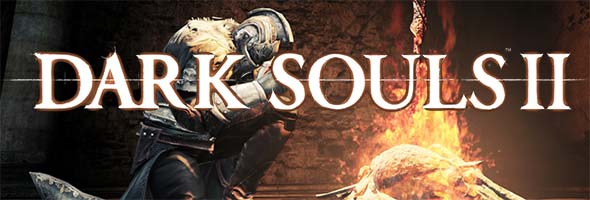
I've been trying to get myself hyped up for Dark Souls III by playing through the Scholar of the First Sin edition of Dark Souls II. I made myself a knight character as well as a sorcerer character. I hadn't played as a dedicated caster in the original release, so I made the sorcerer my primary character for Scholar.
So I put myself through the misery of trying to farm the Lizard Staff for my sorcerer character. This staff is one of the three or four best staves in the game (for Int-based sorcerers), but it's extremely rare. It is only dropped by the two Hollow Black Mages that accompany the Executioner's Chariot in the Undead Purgatory. So it's only even possible to acquire in this one, specific location in the game, and once you beat the boss, the mages don't respawn. So it's even harder than trying to farm the Sea Bow or other such items, because you can't simply go back to the area later and farm the enemies.
To make matters worse, I didn't realize that this staff could be acquired here, so I made the mistake of killing the boss early in the game (before I had equipment to raise my item discovery rate). So the only way for me to acquire this staff now would be to warp to the Undead Purgatory bonfire, use a Bonfire Ascetic to respawn the boss, fight may way back through the Huntsman's Copse, and hope to get the rare drop. I had to fight harder versions of the Purgatory Executioners. It was tough, but doable. I was able to lure them out one at a time and easily dispatch them. It's only if they ganged up on me that I had problems. But then I also had to get past the Red Phantom Tower Knight (who now respawns because of the Bonfire Ascetic). I died several times trying to run past them all, as the Tower Knight's weapon tracking was pretty spot-on. Eventually, I resorted to spell-sniping him from just outside his pursuit range. It was cheap, but I wasn't here to fight, I was here to farm a staff.
The Lizard Staff and Sea Bow are among several items in Dark Souls II that are extremely rare drops.
Then I made it into the Executioner's Chariot boss fight, and I died. And then I died again. And again. This was getting tedious.
Bonfire Ascetics, Soul Memory, and grinding / farming in Dark Souls II
I hate grinding and farming in games. I really do. It's something that I really don't think games need to have anymore. It was something that worked fine when games were relatively short, and grinding or farming for obscure items and secrets was a challenge reserved for the most dedicated players. But Dark Souls II is already long enough without including grinding for hours for rare item drops. It's one thing to hide items behind secret bosses or particularly tough challenges, such that the item is a symbol for overcoming a challenge. It's a totally different thing to hide items behind random drops from enemies that appear literally in one spot in the entire game, and who despawn after beating them.
In Dark Souls II's case, there's even mechanical reasons why this sort of grinding or farming should not be in the game. And that reason is Soul Memory... [More]
67cbe268-c8f0-446d-b36e-1cf6e7d9ec41|4|4.3
Tags:Dark Souls, Dark Souls II, Dark Souls II: Scholar of the First Sin, Scholar of the First Sin, Lizard Staff, sorcerer, mage, Huntsman's Copse, Undead Pergatory, Executioner's Chariot, skeleton, yearn, spell, amber herb, rusted coin, bonfire ascetic, soul memory, farming, grinding, PSN, PSPlus, cloud, PS4, Hidetaka Miyazaki

Even though the player character in Dark Souls can be in a "hollow" state, the player never truly goes hollow. At least, not in the sense that NPCs and enemies have gone hollow.
According to Dark Souls' mythology, the undead are condemned to repeatedly wander Lordran in search of a cure, being unable to permanently die. But for virtually all such undead, this quest is futile. An undead can temporarily stave off hallowing by absorbing souls or infusing themselves with the humanity of someone else. Eventually, an undead dies one too many times, or is worn down by the daily grind of collecting souls, and loses the will to go on -- or is simply unable to continue collecting souls and humanity. When this happens, that undead becomes hollow, loses his sanity and free will, and continues to wander the world as a mindless zombie attacking any un-hollowed that it encounters on sight.
It is unknown how many "Chosen Undead" are brought to Lordran or the Undead Asyulm, but the Crestfallen Warrior at Firelink tells us that many have come before you. Is it possible that all hollows in Lordran were at some point "Chosen Undead", tasked by Frampt to retrieve the Lordvessel and re-kindle the dying flame?
Probably not.
A great deal of the hollows that you encounter in the game were likely former residents of Lordran, and there was no need to select a "Chosen Undead" until Gwyn's power faded to a "cinder", and the fire began to die. This presumably took a very long time - a whole "age".
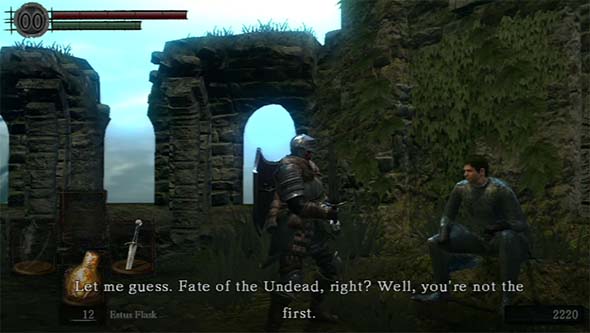
The Crestfallen Warrior informs us that we are not the first "chosen undead",
and suspects that we won't be the last either.
Avoiding hollowness with purpose
Many undead adventurers wandered into Lordran (or were abducted and taken there), and they struggle to hold onto their precious humanity for as long as possible, fighting for their lives in the fear that they, too will go hollow. Some, like the Crestfallen Warrior, resign themselves to the inevitability of hollowness, and find a sense of purpose in warning other new arrivals that they, too, are doomed. Others pursue some seemingly impossible goal or objective in the hopes that the journey will provide them with the sense of purpose necessary to avoid (or at least delay) hollowing. And yet others have taken up crafts or vocations such as blacksmithing, vending, or guarding something in order to keep them focused and avoid hollowing (and to exchange goods or services for the very souls that they need to stave off the hollowing). Keeping such a goal may help keep an undead partially lucid, but they also seem to begin to forget everything else, and only the knowledge of their quest or craft remains. Perhaps, the undead guarding various areas of the game were, at one point, tasked with protecting that place (or something within that place), but have long since lost their mind, and only that compulsion to defend has remained.
Going on "one final quest" seems to provide adventurers with enough focus to hold back hollowing.
But hollowing isn't just a thematic element reserved for non-player characters; hollowing is also a mechanic in the game that affects the player. Whenever the player character dies, you are reborn at the last bonfire in a hollowed state, unable to summon help from allies until you restore your humanity through the consumption of someone else's humanity. In Dark Souls II, hollowing further handicaps the player by cummulatively reducing your total health each time you die, and only restoring your humanity can refill your health meter. In both these cases, the player is not truly hollow; you are only in a state of partial hollowing.
It's unclear whether non-player characters are able to die and restore their humanity, or if deaths contribute to an irreversible progression towards hollowness. There are, after all, apparently hollowed NPCs such as the undead merchant in the Undead Burg and blacksmith Lenigrast in Majula who are sane enough to have kept their shops open. The presence of NPC summon signs hints at the possibility that they, too, are capable of restoring their own humanity through the same mechanisms that you can, but the game itself justifies this with ambiguous appeals to "time distortion" and hypothetical parallel realities that obfuscates the matter - particularly where Solaire and Lautrec are concerned.
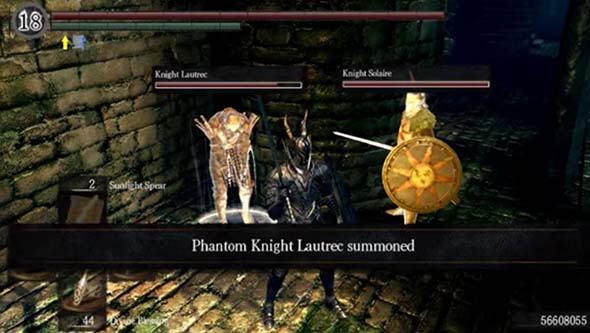
Summoned NPCs may recover humanity as you do, or they're from another time or dimension, or both.
Solaire's dialogue refers to "heroes centuries old phasing in and out.". Solaire may be using the words "world" and "time" interchangeably. This seems to be the game's justification for how summoning works: you may be literally summoning someone from a bygone era into your own time period. Anytime, you are summoned to someone else's world, you are also being transported to another time (past or future, depending on whether or not you finish the game). Solaire and Lautrec seem to somehow come from another time or dimension, but other characters definitely seem to exist within your world and time: Andre, the Crestfallen Warrior, Rhea and her companions, Big Hat Logan and his apprentice, and so on are all undead who have seen many other "Chosen Undead" come to Lordran seeking their destiny.
In any case, it's not until an undead "gives up" that the hollowing process becomes complete. What do we mean by "giving up"? For an NPC, it means that they gave up on life and went hollow, and the player typically ends up putting them down. For the player, it means that you stop playing the game. As long as you continue to play the game, then your character will continue to hold onto a sliver of humanity and maintain his or her sanity for a little while longer. When you put down your controller for the last time, you have condemned your character avatar to finally succumbing to hollowness, whether you recognize it or not... [More]
ce0263eb-66fa-4c8b-b624-2655b7809cd6|3|4.7
Tags:Dark Souls, Dark Souls II, Scholar of the First Sin, Demon's Souls, From Software, undead, Lordran, Drangleic, hollow, hollowing, humanity, souls, zombie, Solaire, Lautrec, Blacksmith Lenigrast, Crestfallen Warrior, Andre of Astora, Rhea of Thorolund, Seigmeyer of Catarina, Big Hat Logan, Gwyn, Sunlight Maggot, God of War, covenant, Warrior of Sunlight, Gravelord Servant, vagrant, perma-death, NPC, lore, Dragon's Dogma, pawn, online, multiplayer, PSN, XBox Live, Steam, emergent narrative
|

| 12 | | | | | | | 60 | | 11 | | | | | | | 55 | | 10 | | | | | | | 50 | | 09 | | | | | | | 45 | | 08 | | | | | | | 40 | | 07 | | | | | | | 35 | | 06 | | | | | | | 30 | | 05 | | | | | | | 25 | | 04 | | | | | | | 20 | | 03 | | | | | | | 15 | | 02 | | | | | | | 10 | | 01 | | | | | | | 05 |
|